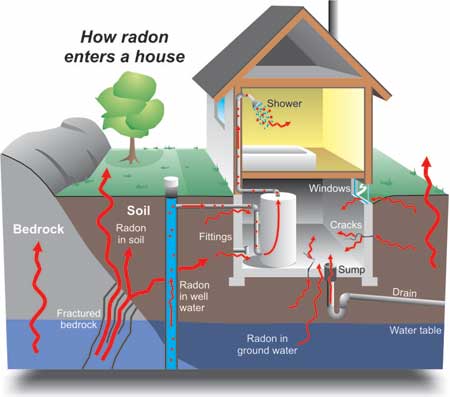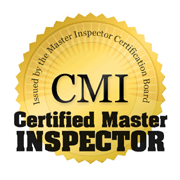Massachusetts Home Inspections YOUR INVESTMENT IS MY CONCERN

Radon In Your Home

Most indoor radon enters a building from the soil or rock beneath it. As radon and other gases rise through the ground, they can become trapped beneath the structure, building up pressure. Because air pressure inside homes is typically lower than the pressure in the soil, this difference forces gases through cracks and openings in floors and walls. Once inside, radon can accumulate and become concentrated, especially in poorly ventilated areas.
Common entry points that allow radon into your home:
*Cracks in solid floors and foundations below grade
*Construction joints
*Gaps in suspended floors
*Sump pits and open floor drains
*Cavities in foundations below grading
*Gaps in floor around utility penetrations (plumbing and wiring)
*Crawl spaces that open directly into the building
*The water supply (especially well water, though this is less common than soil gas entry)
Radon can also be present in water, especially well water. When this water is used—for example, from a faucet—some of the radon is released into the air. Typically, about one ten-thousandth of the radon in water escapes into the indoor air. The higher the radon concentration in the water, the more it can contribute to indoor radon levels. Trace amounts of uranium, which produces radon as it decays, may also be found in certain construction materials such as concrete, brick, granite, and drywall. While these materials can emit radon, they are rarely the primary source of elevated indoor levels. In some cases, even outdoor air drawn into a building can slightly contribute to indoor radon concentrations.
The average radon level in outdoor air is about 0.4 picocuries per liter (pCi/L), though it can be higher in certain regions. While some geographic areas are more prone to radon issues, any home—regardless of age, construction type, ventilation, or whether it has a basement—can have elevated radon levels.
Radon levels are often higher in homes that are well-insulated, tightly sealed, or built on soil rich in uranium. Basement and first-floor areas typically have the highest radon concentrations due to their proximity to the ground. Homes located below the third floor in multifamily buildings are also particularly at risk.
Here is what my clients have to say about my home inspection services:
Press F5 (on your keyboard) for additional testimonials
Buying a home is arguably the most important, exciting and nerve-wracking purchase a person will ever make. This is the reason you need a great home inspector, and Dave Valley is just that. He is empathetic – he understands and appreciates the various emotions a potential home-buyer goes through. Most importantly, Dave provides you with objective information so you can make the most informed decision possible.
It was a pleasure working with Dave – he contains all the qualities that make a great home inspector – he is the consummate professional, prompt, courteous, meticulous in his detail and honest. Dave was reasonably priced – in fact Dave charged me the same amount I spent 10 years earlier on a smaller house and provided a far better work product.
Prompt
I arrived at the house at the agreed upon time on a cold and nasty day, and found Dave outside inspecting the exterior of the home. He was already a half hour into his inspection – I think this exemplifies and is symbolic of the fact that Dave is respectful of his client’s time.
Courteous
Dave was pleasant to deal with, personable and thoughtful not only to his client but also to the buyer’s real estate agent.
Detail-oriented
Dave spent almost four hours in his investigation of a 2,000 square foot house. He answered all my questions and reviewed every observation he had with me. David provided a detailed report, and encouraged me to call and email him to discuss the report and to ask questions.
Conclusion
The highest compliment I can give Dave is to say that I would use him again and will encourage and recommend him to others.
Michael S. Giaimo














